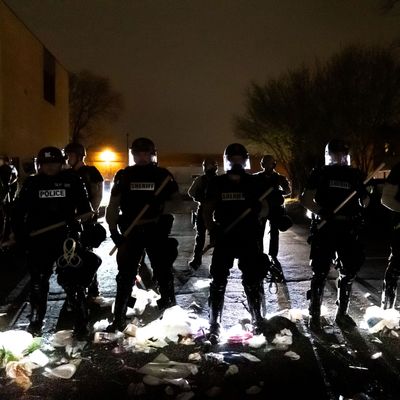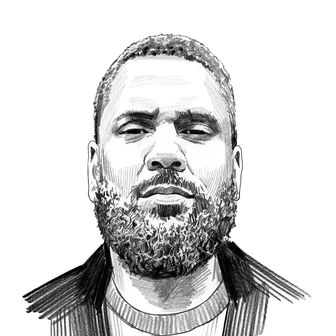
On Sunday afternoon, two weeks into the criminal trial of Derek Chauvin, the ex-Minneapolis police officer who killed George Floyd last spring, police in nearby Brooklyn Center, Minnesota, shot and killed another Black man, 20-year-old Daunte Wright. The events’ concurrence highlighted a contradiction: For all the efforts by prosecutors and fellow officers to paint Chauvin as a rogue, officers in Brooklyn Center were doing comparatively standard police work when they encountered Wright, and the outcome was the same. Needless death is not the product of policing gone wild. It’s an inevitable outcome of policing as it was intended.
According to reports, officers stopped Wright for an alleged traffic violation and tried to detain him after discovering a warrant for his arrest. Police say they ordered Wright out of his vehicle, but the 20-year-old climbed back in when they moved to cuff him and officer Kimberly Potter, a 26-year veteran of the department, shot him. Wright’s car rolled several blocks before crashing. Police and medical workers pronounced him dead soon after. Protests erupted, continued into Monday morning, and resumed that night, with some residents hurling “rocks, bags of garbage, and water bottles” at riot-gear-clad police, who responded by firing rubber bullets and chemical agents at the demonstrators. In subsequent statements to the press, Brooklyn Center police chief Tim Gannon said Officer Potter killed Wright by mistake — she meant to discharge her Taser rather than her firearm, he said, citing publicly released body-camera footage where she seems surprised to have fired her gun. “I’m the leader of this department,” Gannon said on Monday, articulating in broad terms how the situation might be resolved amid heightened tensions. “They expect me to lead. Create a safe city. That’s what I’m trying to do.”
Police seek to create safety — a nebulous state of enforced order — by deciding who is dangerous and responding to them with violence. Even as public opinion has soured on much of their conduct in the past year, this remains, to the vast majority of Americans, a key part of what law enforcement agents are supposed to do. This is evident in broad support for reforms like establishing uniform standards for how and when police can use force — paired with more or less split opinion on whether police should keep receiving military-grade weapons and equipment — compared with less popular changes aimed at eliminating the police’s right to use violence altogether, like defunding as a precursor to abolition. Even if one agrees that a United States without armed police is a dangerously utopian proposal, it is hard to dispute that anything less will preserve this discretion to apply violence based on subjective judgment — which, in turn, will continue to spark the type of heated protests we’ve seen grow larger over the past year. As long as they exist, the police will be one split-second decision away from assaulting or killing someone because they view them as a threat. People like Daunte Wright are and will continue to be casualties. This will keep happening.
For this reason, the rough week that Derek Chauvin’s criminal defense just had should be interpreted with restraint. By all accounts, things aren’t going well for the former Minneapolis police officer, who is being tried less than ten miles away from where Wright was killed. Two weeks into his trial, where he faces charges of second-degree manslaughter and second- and third-degree murder, Chauvin has faced rare rebuke in the courtroom from his own former boss, Minneapolis police chief Medaria Arradondo. Arradondo testified for Chauvin’s prosecution last week that the former officer “absolutely” violated department policy when he knelt on George Floyd’s neck in May 2020. “Once Mr. Floyd had stopped resisting, and certainly once he was in distress and trying to verbalize that, that should have stopped,” Arradondo said. This was significant because police rarely testify against their own. The chief’s decision to do so was transparently geared toward creating distance between Chauvin’s conduct and that of officers who do things the way they’re supposed to — that is, according to normal rules and standards. Part of what generated last summer’s protest furor was the torturous cruelty that went into killing Floyd. To watch him lose his life over the course of eight and a half agonizing minutes, handcuffed on his stomach with an officer kneeling on him, marked for many viewers a striking departure from the typical video-recorded police killings, which are characterized by swift judgment and hair triggers.
But the distinction is less meaningful than it appears. Even if Officer Potter killed Wright by accident, using her firearm rather than the intended Taser, as is being claimed, police regularly shoot people unnecessarily when they resist arrest, make furtive or sudden movements, or reach abruptly into their cars. By law, these are considered reasonable grounds for lethal force, and are almost never met with administrative rebuke, let alone legal consequences. The exact circumstances around Wright’s death are still being investigated. But even if they unfolded just as they seem — a man fled arrest and was shot — it was simultaneously tragic, unnecessary, and utterly normal. And if normalcy produces outcomes that are this comparable to the supposed aberrations, like Chauvin, then it’s hard to imagine any of the reformist proposals currently on offer making more than a dent in the recurrence of such incidents. Much fanfare, most of it negative, greeted the Minneapolis City Council’s announcement last year that it intended to disband the city’s police department and rethink their public-safety apparatus. But even in the face of such an ambitious proposal — which will be subject to a public input process in the coming months and likely be put to a ballot initiative in November — more city residents think the police department should be kept in place than believe it should be gotten rid of, even as most support some funding reallocations.
Public expectations should reflect this. If the types of reform that have enough popular support to become law continue to be items like mandating the use of body cameras; expanded data collection; and creating uniform national standards for the use of force, a ban on chokeholds, and ending qualified immunity — which would allow police to be sued for violating people’s rights — Americans can both expect a reduction in rates of police violence against civilians and be confident that killings like Wright’s will continue to happen with unconscionable frequency. That’s because none of these proposals will change the function of the police. Their trade is violence. They can be compelled to be more discreet and judicious, but they cannot stop. This is an acceptable trade-off for many people, who believe their personal welfare depends on this brand of violent intervention. But to those for whom deaths like Wright’s are truly unacceptable, it’s worth thinking harder about what changes would actually prevent them. To do otherwise is to concede that deaths like his are the cost of doing business. Most people will make that concession. Nobody has to.






























